SUMMARY
“Rome was not built in a day!” This well cited saying could be equally
applied to the survey of Rome and its many outskirts of centuriations
radiating from the nucleus of the central square. This being so it was
clearly to take many years in the field by the four Greek Surveyors
charged by Julius Caesar to chart the entire known world.
Through exhilarating research I can tell you how long this task took as
well as the names of the surveyors who carried out the survey plus the
coordinator commissioned with the duty by Octavian himself ! The story
behind the Survey of the World varies between scholars but one version
of the tale is brilliantly retold in text and images in spectacular
fashion on the legendary Hereford Mappa Mundi (dated to c. 1290-1300).
All references credit Julius Caesar with making the initial decree to
make a survey of the whole of the Roman World in conjunction with his
closest consort Marc Antony sometime around the year 45-44 BC. Knowing
that in March of 44 BC (at the Ides of March to be precise) he was
assassinated it is possible that a written order could have been
delivered by the adopted son of Julius Caesar, Octavian, to the
surveyors to confirm his concurrence with the original action or the
representation of this alleged royal order on the medieval map could be
merely the whim of its creator. Octavian’s greatest general (later to
become his son-in-law !), Marcus Vipsanius Agrippa, was appointed as the
overall supervisor of the great mapping project which was more than
probably not finally completed until some years after his death. There
is a growing number of scholars such as my friend Michael Ferrar
favouring a date 10 years earlier for the start of the Great Mapping
Project but as there are so few sources (two in fact!) which have
reported on the years associated with the exercise I will place my
reliance on the times nominated by Julius Honorius, the first and oldest
extant report on it.
In this paper you will hear about the masterpiece of cartography which
highlights most of the men responsible for the Survey of the known
World, along with aspects of Roman land surveying which underpinned the
program of colonisation and settlement within the Roman Empire. I will
also give you with the name of the cartographer responsible for this
brilliant piece of late thirteenth century mapping together with the
history of the historic repository where it was rediscovered many
centuries after its disappearance. It is still housed in the Cathedral
from which it derived its name today thanks to some most generous
benefactors and enthusiastic heritage fanatics.
It is a truly incredible revelation that we have the approximate
commencement time of the survey of the entire ancient world and just how
long the arduous exercise took but to ponder that we even know the names
of all of the people involved in the awesome undertaking is staggering
to the imagination. Well get ready to be thrilled; get ready to be
amazed because I am about to transport you back to a time of majesty and
conspiracy closely followed by an extended period of peace during which
four Greek Surveyors took on the survey of the world and actually did
it!
1. INTRODUCTION
To be given the commission to survey the world sounds like and certainly
is a monumental contemplation but this exact responsibility was bestowed
upon four “extremely learned men” by the most powerful man in the world
at the time of this momentous instruction – Julius Caesar ! There are
some unsubstantiated sources which purport that this great emperor
himself first started his career in the ranks of the army as a surveyor
of the roads of Rome, legendary for their straightness and right angled
intersections but I must leave the verification of this exciting
possibility to future investigation while I mesmerise you with this true
tale of epic surveying during the era that it is said the streets of
Rome were paved with gold !
The entirety of the known world at that time (45/44-13/12 BC) included
Asia, Africa and Europe, with many portions of these continents under
the occupation of the Roman Empire, a not insubstantial expanse of
territory in anyone’s imagination ! The late 4th/early 5th century Roman
historian Julius Honorius states that the entire earth (“omnis orbis”)
was surveyed by four surveyors of Greek extraction who were selected by
Julius Caesar and his co-consul Marc Antony. Contemporary accounts about
these surveyors refer to four such “most able men” but later reporters
erroneously drop one of the agrimensori in favour of only three men of
measurement, which slightly contorted tale has been adopted on the
Hereford Map.
Initially I am going to give a brief outline of the training and
techniques which would have been instilled into the men entrusted with
surveying tasks during the Roman Empire along with the calibre and
expertise of the highly regarded Guild of Experts from which four were
chosen to do the ambitious bidding of their imperious leaders.
2. THE MASTERY OF ROMAN SURVEYING
Even in the very early days when Romans were predominantly a nation of
farmers they had a mythical obsession with the land to which they
attributed great antiquity. The Roman Surveyors were known as
“agrimensori” (literally “measurers of land”) or “gromatici” (“users of
the groma” – which is an ancient Roman surveying device consisting of a
cross mounted on a bracket, fitting into a staff, with a plumb bob
hanging from each of the four ends to enable the laying out of straight
lines at right angles to each other). Thus the Roman subdivision of land
known as centuriation carried on the tradition of the Egyptians and
Greeks before them of laying out towns and land parcels in orthogonal
patterns with parallel streets intersecting at ninety degrees mainly
comprising allotments of rectangular shape.
As an illustration of the extent to which the Romans incorporated the
establishment of new towns into their folkloric sagas the writer Virgil
describes how Aeneas founded a city in Sicily:
“Meanwhile Aeneas marks the city out
By ploughing; then he draws the homes by lot”
All Roman Surveyors were aware through their training of the old
custom whereby the limits of a new town were marked out by the consul by
ploughing a furrow around it. Another author Ovid, a studier of the law
including that pertaining to surveying, said that the dividing up of
land with balks (limites) by a “careful measurer” (cautus mensor)
emphasised the importance attached to the art of surveying.
The line drawn around a town was referred to by Virgil as sulcus
primigenius (“the original furrow”) and was monumented with boundary
stones according to Tacitus and Plutarch. Actual boundary stones have
been discovered at Capua placed during the Second Triumvirate bearing
inscriptions “By order of Caesar (Octavian), on the line ploughed”.
|
The Romans even had a god called Terminus - God
of the Boundary Stones closely affiliated with the principal
deity Jupiter. Indeed it is the Romans who introduced the Feast
of Terminalia during which the Town Consul and his officials
would walk around the town bounds beating drums to ward off evil
spirits, a ritual which survived down through the centuries into
the modern era when statutes required the enactment of “Beating
the Bounds” in an identical style to designate the extent of the
town limits outside of which legal jurisdictions changed. During
the 1830’s in New South Wales the same concept of boundary
stones was laid out under The Police Act where the town limits
were delineated by imposing boundary monuments. In Sydney and
Parramatta it was required by this legislation to conduct an
annual beating of the bounds in a reenactment of the Roman
event. In Parramatta the whereabouts of eight of the original
nine boundary stones are known. |
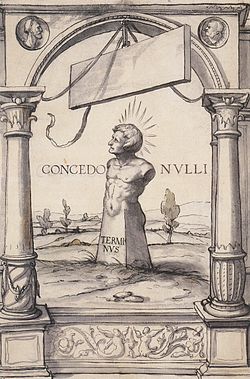 |
| |
Figure 1: The bust of Terminus
on a boundary stone “Never yield” |
|
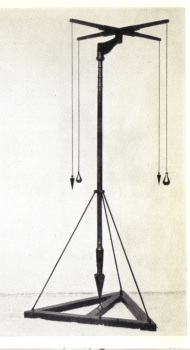 |
The Roman land surveyors did not only measure the land, they
laid it out with more careful planning and more precisely than
by any other nation at any time until the late eighteenth
century ! With methodical and practical purpose the Roman
surveyors of Caesar prudently began measuring from the Augur’s
starting point then set about the laying out of the streets and
allotments of the new town which always had two main roads
intersecting at right angles at the heart of the establishment.
The first line to be laid down was the principal street called
the decumanus maximus which would be the widest thoroughfare
running in a north-south direction with the secondary street
known as the kardo(cardo) maximus intersecting in the centre of
the main road at right angles thus orientated towards the east
and west. |
|
Figure 2: A Roman Groma |
|
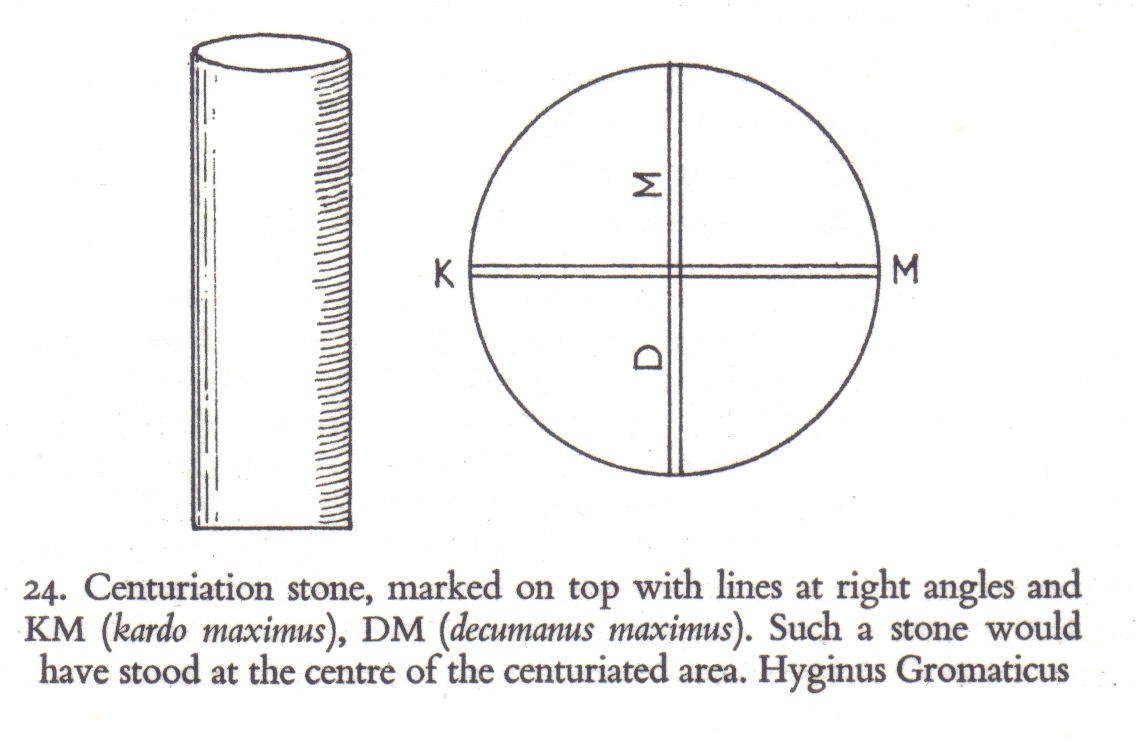
Figure 3.
|
In Augustan
colonies for veterans the main street had a width of 40
feet with the cross street set at a lesser width of 20 feet and
a centuriation stone cylindrical in shape bearing the engravings
“DM” and “KM” with double lines intersecting on the top of it
was placed at the centre of the centuriated area. Some of these
road intersection monuments were made of set out at right angles
using a groma (see figure 2) the distances were measured with 10
feet long rods (decampeda) and carefully checked. It has been
well shown through the examination of many archaeological sites
that even the interconnecting highways between towns were also
planned and surveyed before their construction. The supreme
precision of the levelling achieved in their thousands of
kilometres of aquaducts stand as a proud memoriam to the
accuracy and skill of the ancient surveyors. There are many
areas typical of the centuriations laid out by the Roman
surveyors with a specific fine example existing in the Orange
Cadastre of France both over the landscape and shown on engraved
stelae. |
Surveying equipment still used in 79 AD was found in the Surveyor’s
Workshop of Verus (or Vero) at Pompeii in 1912. Among the artifacts
discovered were the metal pieces of a groma, a portable sundial, a
folding ruler with one fold, 1 Roman foot long, 2 bronze compasses, the
bronze parts of two wooden chests used to store fieldbooks and drawing
implements, pincers (9 cm long), a conical ferrule (6.2 cm in length),
16 long, thin iron tools, an ink bottle and stylus. At the National
Archaeological Museum in Naples there were displayed three plumb bobs
said to have their origin in Pompeii along with some of the
aforementioned items. The metal end pieces of a measuring rod were also
unearthed at this fabulous World Heritage site. Hero also refers twice
to the utilisation of tautened ropes or cords for the measurement of
longer distances.
In 55 BC Julius Caesar passed agrarian land reform legislation known as
the Lex Mamilia part of which has been preserved within the Corpus
Agrimensorum, a series of texts copied through the centuries by the
hands of the monks attached to the scholastic religious monasteries
renowned for their libraries of antiquarian knowledge. This legislation
which laid down conditions for the law associated with boundary disputes
was still in force 140 years later when Frontinus wrote of its
provisions which specified penalties for offences against it as well as
for removing or altering the position of boundary stones. There were
particular conditions set down for any land disputes within five (5)
feet of any subdivision boundaries and the agrimensore (surveyor) had
ultimate jurisdiction over internal land boundaries in addition to the
landward limits with adjoining colonies which whenever possible were set
upon natural features like rivers or mountains. As well as surveying,
parcelling and allocating land the mensor (measurer) had to ensure that
boundaries were properly established and marked out – the technical
terms for this being terminatio or determinatio.
The outer boundary of the Roman Empire was termed limes while the
boundaries within a colony such as Italy were described as limites.
Augustus Caesar divided Italy into eleven (11) regions as follows (with
some lesser tribes omitted):
1. Latium, Campania
2. Apulia, Calabria
3. Lucania, Brutii
4. Samnites, Marsi, Paeligni, Sabines etc.
5. Picenum
6. Umbria, Ager, Gallicus
7. Etruria
8. Gallia Cispadana
9. Liguria
10. Venetia, Istria
11. Gallia Transpadana
It is said that these above divisions remained with very little
alteration right down to the time of Constantine the Great who was
Emperor between 306 and 337 AD who really must have treasured his
surveyors because he exempted them from paying tax!
3. SURVEYORS – THE ULTIMATE LAND EXPERTS!
Alright, we have hundreds of years of Roman adoration of the land
administered through strict legislation and established legal precedence
which were the sole dominion of the cadastral (land) surveyor, but did
this situation last after the Fall of the Roman Empire in 476 AD with
the conquest by Odoacer, a German Chieftain ?
Not long after this imperial collapse a letter was written in 511 AD by
the Roman official Magnus Aurelius Cassiodorus Senator (c.490-585 AD),
more commonly referred to as Cassiodorus, concerning a bitter and
violent land dispute between the estates of two noblemen named Leontinus
and Paschasius in which he states:
“Augustus made a complete survey of the whole
‘Orbis Romanus’, in order
that each taxpayer should know exactly his resources and
obligations. The
results of this survey were tabulated by the author Hyrummetricus.
The
Professors of this Science [of land surveying] are honoured with a
more earnest
attention than falls to the lot of any other philosophers.
Arithmetic, Theoretical
Geometry, Astronomy, and Music are discoursed upon to listless
audiences,
sometimes to empty benches. But the agrimensor (land
surveyor) is like a
judge: the deserted fields become his forum, crowded with eager
spectators. You would fancy him a madman when you see him walking
along the most devious paths. But in truth he is seeking for the
traces of
lost facts in rough woods and thickets. He walks not as other men
walk. His path is the book from which he reads; he shows what he
is
saying; he proves what he hath learned; by his steps he divides the
rights
of the hostile claimants; and like a mighty river he takes away the
fields of
one side to bestow them on the other.”
4. HEREFORD – THE CATHEDRAL AND THE MAPPAMUNDI
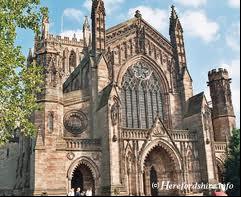 |
With the
original stone construction from the 7th century destroyed after
200 years by Aethelred of Mercia the subsequent reconstruction
by Edward the Confessor lasted for only a handful of years till
it was sacked and burnt in 1056 by an army of Welsh and Irish
forces led by Gruffydd ap Llywelyn. The current Hereford
Cathedral was built within the ruins of the last one in 1079 not
too long after the Norman Conquest of William the Conqueror in
1066. Situated in the County of Herefordshire the full name of
the holy building is the Cathedral Church of Blessed Virgin Mary
and St. Ethelbert in the Diocese of Hereford designed in the
Gothic style. The final additions were commissioned by Bishop
Aquablanca in the mid 1200s being completed later in that
century under Bishop Swinfield. |
|
Figure 4. Hereford Cathedral |
|
Within the Cathedral in the late 1800’s found in a storage room was a
medieval Mappa Mundi which had formerly hung on the wall of one of the
shrines for hundreds of years. Having been masterfully penned around
1290-1300 by Richard of Holdingham, identified as Richard de Bello (of
Battle), he is said to have been the prebend of Lafford (modern day
Sleaford) in Lincoln Cathedral around 1278-1283. Later he became an
official of the Bishop of Hereford, when in 1305 he was appointed
prebendary of Norton, and a Canon in Hereford Cathedral. His life after
1313 has not been traced but his date of death was c. 1326. Richard even
tells us directly that he was the one who created the masterpiece with
an inscription in the bottom left hand corner. He is also probably the
individual on horseback situated in the bottom right hand corner looking
towards his declaration. The horse rider has also been suggested as Paul
Orosius, another 5th century historian but proof of the identity has not
been verified.
5. APPOINTING THE
SURVEYORS OF THE WORLD
It is reported by various sources as well as being supported by a
prominent inclusion within the Pentagonal Frame of the Hereford
Mappamundi at the left right hand side that the measurement of the whole
world was ordered by Julius Caesar “to be made by four very wise and
chosen men,” and that “this measurement was begun in the consulship of
Julius Caesar and M. Antonius.” It is also said that “three Greeks were
appointed for this purpose, Nichodoxus, Theodocus, and Polyclitus” which
is the version that is represented on the Hereford Map with the names of
the three surveyors also shown as Nicodoxo, Teodoco and Policlito in red
ink around the perimeter of the map. Indeed there a number of variations
of each of the names of the measurers of the world of differing origins
including Nicodemo/Nicodoxo/Nichodoxus/Nichodomo and Nicodoso for one,
then for the second individual Theudoto/Teodoco/Theodocus and Teodoto
with only minor alternatives for the third member of the group as
Polyclito or Policlito. The fourth surveyor mentioned in earlier
manuscripts such as the Vatican MS from 1209 is said to be Didymus or
Didymo who is alleged to have been entrusted with the survey of the
western regions which were known as “Occidentalis.” It is unsure just
what occurred to exclude this fourth man from the team but his duties
are said to have been relegated to Teodoco who is depicted on the
Hereford Chart to have measured the north (“Septentrionalis”) and the
west (“Occidentalis”). Installed to oversee this phenomenal project was
the brilliant young general Marcus Vipsanius Agrippa who was only aged
19 at its commencement having been born in 63 BC, the same year of birth
as Octavian (later to become Caesar Augustus). At the time of the
assassination of Julius Caesar in 44 BC he was studying with the future
Roman Emperor at Apollonia. He was later to marry the sister of his
Emperor as well as gaining victory in many notable battles against the
fleet of Pompeius followed up by the critical overthrow of Antony at
Actium in 31 BC which provided the mastery of Rome and the empire of the
world (which was still being surveyed!) to Octavian. In 26 BC the Senate
bestowed the imperial title of Augustus upon Octavian.
With as much of the information available to him at the time Agrippa is
said to have started a contemporaneous Map of the World for his Emperor.
His appreciative leader is said to have completed the map himself and
had it engraved on marble for later placement in the colonnade built by
Agrippa’s sister Vipsania Polla. Along with this world map Agrippa is
said to have written a lengthy treatise on the cosmography of the known
world containing a comprehensive compilation of the places surveyed on
the known earth by his trusted team of Surveyors. The final World Map
referred to by Pliny the Elder early in the first century AD is likely
to have been this map. The existence of such a map has been attested by
various sources including Strabo.
I am sure that by now you will want to know the answer to one question:
“Just how long does it take to survey the world ?” Well it is scarcely
believable, but we do know EXACTLY just how long it took to “measure the
world.” From Julius Honorius the four Surveyors of the Roman World
completed their allocated duties in the following periods: Nicodemus
measured all of the east (“Oriens”) which took him 21 years 5 months and
9 days while the southern colonies (“Meridiana Pars”) were the sole
obligation of Polyclitus occupying his time for the longest period of
the four at 32 years 1 month and 20 days. It is stated that Didymus
measured the west (“Occidens”) over a time of 26 years 3 months 17 days
and the north (“Septentrionalis”) was determined by Theodotus over a
period of 29 years 8 months. Thus the full task was completed between
45/44 BC and 13/12 BC, possibly in the year of Agrippa’s death at the
young age of only 51 !!! Perhaps the receipt (if these dates are
possible!) of the final survey information was too much excitement for
him!
With regard to this precise timing of the completion of the Survey of
the World it has been suggested to me that this would not be accurate as
they used a different calendar at that epoch of history. Well these
timings are compatible with our modern collations of time as the modern
calendar which we use today was adopted by Julius Caesar on 1 January in
45 B.C. with twelve months consisting of 365 days and an extra day every
four (4) years being the leap year to catch up the one quarter of a day
overlap caused by the earth’s orbit around the sun. It would not be
coincidental that only two of the months are named after Roman Emperors,
July and August, reflecting the most significant contributions made by
these two giants of the Roman Colossus to its preeminence in the ancient
World, not the least of which was the incredible exercise of surveying
it!
6. REPRESENTATIONS ON THE HEREFORD MAP
The medieval cartographic masterpiece known as the Hereford
Mappamundi was estimated to have been completed in about 1290 to 1300 AD
and is currently housed in the magnificent Norman era cathedral which
gave the work its name in the west of England.
The map is of the genre T-O typical of the religious style of mappamundi
of this period such as the contemporaneous St. Beatus Map (c.1050),
Psalter World Map (c.1265), and Ebstorfer Map (mid-late 13th century).
Shown as a flat circle surrounded by ocean the known world comprised
Europe, North Africa and the explored section of Asia with the
horizontal bar of the “T” dividing Europe from Asia and the vertical
line being the Mediterranean Sea. Such maps were religious concoctions
with the Holy City of Jerusalem occupying a disproportionate area of the
chart at the centre while the Earthly Paradise was placed at the top of
the map which was actually the Far East. Thus we have north on the left
and south on the right. The base for the masterpiece was the traditional
vellum which was treated calf skin even used during the early period of
Land Titling in Australia. Even though the mappamundi has exaggerations
and some misrepresentations driven by religious preoccupations it
nevertheless pays an extensive level of detail to the depiction of
geographically and historically authentic information illustrated in a
most artistic and masterful way.
The material portrayed on the Hereford Map is declared as being based
upon Orosius’ History of the World itself heavily reliant on the earlier
writings of The Bible and Pliny the Elder who was killed at the Vesuvian
eruption which buried Pompeii in 79 AD as witnessed by his nephew Pliny
the Younger. According to Meryl Jancey in the “Mappa Mundi – a brief
guide” the purpose for crafting the great map was as a medium of
religious awe to encapsulate in a spectacular visual way to a vastly
illiterate congregation the wonders of man and the natural world which
were attributable to the Almighty God. The figure of Christ, the Virgin
Mary and a few angels near the top of the map at the Day of Judgement
gave the bemused civilians a path to salvation through which they could
extract some solace for their existence.
The majority of the writing on the map is in black ink with red and gold
leaf for emphasis while blue or green was used for rivers and seas. One
exception is the depiction of the Red Sea in red colouring. Scalloped
patterns showed mountain ranges with towns identified through the walls
and towers of the local structures found within those places. In
addition to the man-made features unique to an area which had been
described by the visiting surveyors and world travellers the known
regions of the map are situated by their geographical elements and
natural features. However when the lands are unknown for authentic
detail mythical creatures and beings are drawn to make the plan a
mixture of fact and fiction. Most locations bear icons representative of
their identity such as the Pyramids and Sphinx for Egypt, and, of
course, Hereford indicated alongside the River Wye by the drawing of the
Cathedral which bears its name.
7. THE SURVEY OF THE WORLD AS SHOWN ON THE MAP
Engravings and illustrations displayed on the historical map provide
a most exciting chronicle of the Surveying of the World Project first
proposed by Julius Caesar in about 45-44 BC with decorative inscriptions
and even sketches of three of the four Surveyors of Caesar including
their names beside them. This antiquarian world map portrays the later
version relating to the formation and execution of the scheme assembling
its citations and images based on the account of the Survey of the World
by Paul Orosius from the 5th century which omits the surveyor of the
West, Didymus.
Between the outside circular delineation of the major oceans and the
perimeter of the map edge is said to be The Pentagonal Frame. Within
what appears to be a vertical text box which then slopes upwards at
about 45 degrees at the top left of the map inscribed in red capital
letters is the declaration that: “The terrestrial landmass began to be
measured under Julius Caesar.” The next similar pronouncement on the top
right hand side of the chart and sloping at a similar angle downwards
says: “Nicodoxo measured all the east.” The next vertical and horizontal
writing at the bottom right hand corner proclaims: “The southern area
was measured by Policlito”, while just across on the bottom left hand
side within a mirror image right angled box is broadcast: “The north and
west were measured by Teodoco.” How incredible is this that depicted on
this map we actually have the names of three of the four men being the
chosen surveyors that produced Caesars’ Survey of the World by 13/12
BC!!!
Even more invigorating is that the cartographer has penned a scene at
the bottom left hand corner of the map which depicts three of the four
men receiving their written instructions under seal from Caesar Augustus
himself (see Figure 5). We know this because the names of three of our
four Surveyors are written in black text alongside their figures -
Nichodoxus, Theodocus and Policlitus. Upon the sealed document the
instruction reads: “Go into the world and make a report to the Senate on
all its continents: and to confirm this [order] I have affixed my seal
to this document.” The seal of the emperor, Augustus Caesar, hangs from
the paperwork while the outstretched hand of what may be Nichodoxus
touches the end of it in preparation for its receipt. Such theatre is
the province only of the map’s creator since it was not until 26 BC that
Octavian was installed as Caesar Augustus by the Senate making such an
event at odds with that depicted as a showpiece on the ecclesiastical
map.
The further inscription above the figure of Caesar Augustus is an
unlikely reinforcement of this action from the Gospel of St. Luke which
relates the following: “Luke in his Gospel: There went out a decree from
Caesar Augustus that all the world should be described” which is an
obvious attempt to offer Biblical recapitulation for this significant
historical event, but once again this reference is to a second taxation
census and not the subject of the original Survey of the World.
Regardless of inaccuracies of some aspects of the Hereford Map it is
still an invaluable record of how cartographers viewed and depicted the
world during medieval times as well as being an enduring artifact which
has survived the test of time to be available for all those fortunate
enough to know about its existence. Despite the flaws in some dating of
events as well as the patent omission of one of the four Greek surveyors
involved in the massive project to Survey the World there is no
reasonable dispute about the veracity of the exercise. Further elevating
the status with
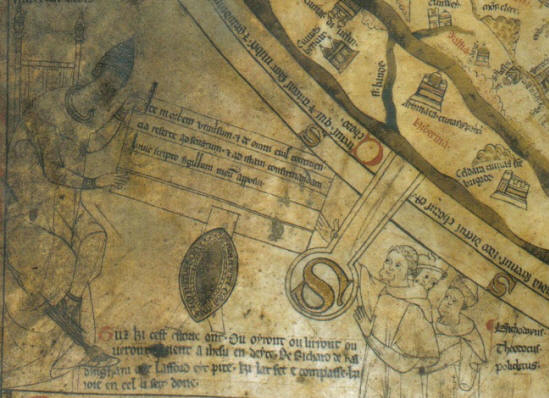
Figure 5: Three of the four surveyors
of Caesar’s World Nichodoxus, Theodocus and
Policlitus are personally handed their official order to: “Survey The
World”
by Caesar Augustus. (part image reproduced by courtesy Brepols
Publishing)
which the land surveyors of ancient Rome had attained during the
might of this imperial civilisation it is not surprising that erudite
and astute Roman officials such as Cassiodorus when referring to the
agrimensore (land surveyor) could proclaim:
“He walks not as other men walk!”
8. CONCLUSION
Whatever reasons motivated the two great Roman Emperors to order a
Survey of the World have been postulated by eminent cartographic
researchers possessed of much more ancient knowledge than myself but the
fact that it WAS done is not disputed. Through this ancient action the
Survey of the World has been immortalized along with “the four very wise
and chosen men” who completed the assignment.
With such a religious atmosphere surrounding this medieval mappamundi it
is not hard to comprehend just how sacred the land has been and still is
to tribal peoples who still occupy properties owned by their ancestors
for thousands of years. Indeed the distribution of land is said in The
Bible of the Christians to have been made by God Himself. Upon this
reflection I shall leave you with a wonderful image from a 13th century
illuminated manuscript to accompany the Biblical citation: “When he
prepared the heavens, I was there when he set a compass upon the face of
the depth.”
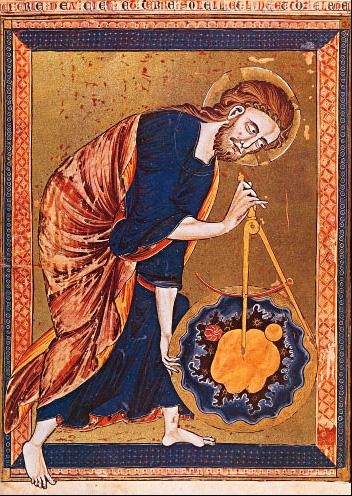
Figure 6: God measures his newly
created World as shown in a sketch
from a 13th century illuminated manuscript. It appears to be
flat AND round just like our Hereford Mappa Mundi?!?
DEDICATION AND APPRECIATION
May I take this opportunity to dedicate this paper and presentation to
the four legendary surveyors personally chosen by Julius Caesar to
“Survey the World”:
- Nicodemus
- Didymus
- Theodotus
- Polyclitus
I would also like to express my sincere appreciation to our Italian
colleagues who are staging this FIG Working Week and History Workshop
during a time of serious economic and social uncertainty. Grazia!
BIBLIOGRAPHY
- Dilke, O.A.W., The Roman Land Surveyors. (David & Charles:
Newton Abbot,
1971).
- Harvey, P.D.A., Mappa Mundi. The Hereford World Map, (London:
British
Library: Toronto: University of Toronto, 1996).
- Hodgkin, Thomas, The Letters of Cassiodorus, (Oxford University
Press, 1886).
- Honorius, Julius, Cosmographia Julii Caesaris: A. Riese, ed.,
Geographis Latini
minores.
- Jancey, Meryl, Mappa Mundi – a brief guide, The Dean & Chapter
of
Hereford, (1994).
- Westrem, Scott D., The Hereford Map, (Brepols Publishers,
Turnhout, Belgium,
2001).
BIOGRAPHY
Private land surveyor since 1973, Bachelor of Surveying (UNSW 1978), MA
(Egyptology) from Macquarie Uni., Sydney (2000). Now Director of Brock
Surveys at Parramatta (near Sydney). Papers presented worldwide inc.
Egypt, Germany, France, Hong Kong, Canada, Brunei, New Zealand, Greece,
UK, USA, Israel, Sweden and Morocco. Since 2002 regular column Downunder
Currents, in RICS magazine (London) Geomatics World. Dedicated
contributor to FIG Institution for the History of Surveying and
Measurement awarded FIG Article of the Month March 2005 for paper “Four
Surveyors of the Gods: XVIII Dynasty of New Kingdom Egypt (c. 1400 BC)”
Institution of Surveyors NSW Awards – Halloran Award 1996 for
Contributions to Surveying History and 2002 Professional Surveyor of the
Year. First international Life Member of the Surveyors Historical
Society (USA), Life Member Rundle Foundation for Egyptian Archaeology,
Foundation Member Australian National Maritime Museum and Friends of the
National Museum of Australia. Member of International Map Collectors
Society, Royal Australian Historical Society, National Trust of
Australia, Historic Houses Trust of NSW, Parramatta and District
Historical Society, Hills District Historical Society, Prospect Heritage
Trust and Friends of Fossils (Canowindra).
CONTACTS
John Francis Brock
P.O. Box 883,
PARRAMATTA NSW 2124, AUSTRALIA
Tel 0414 910 898 Fax +61 (0)2 9633 9562
Email:
brocksurveys@bigpond.com































